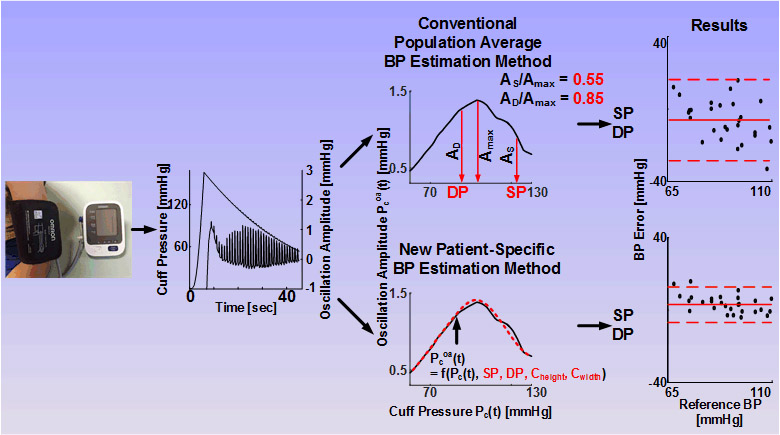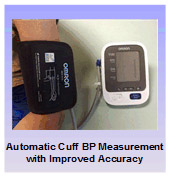
Oscillometric devices are widely used for automatic cuff blood pressure (BP) measurement. These devices act as both an actuator to alter the transmural pressure of the brachial artery via cuff inflation/deflation and a sensor to measure the pressure inside the cuff. The measured cuff pressure indicates the applied pressure and is superimposed with small oscillations representing the pulsatile blood volume in the artery. Since the arterial compliance is nonlinear, the amplitude of the cuff pressure oscillations varies with the applied cuff pressure. BP is estimated from the oscillation amplitude versus cuff pressure function (i.e., “oscillogram”). However, the BP estimation method is based on population averages. For example, the conventional method is to estimate diastolic and systolic BP (DP and SP) as the cuff pressures at which the oscillogram are some fixed-ratios of its maximal value. As a result, the devices may only work well in subjects with typical BP levels. A patient-specific method was developed to estimate BP from a standard oscillogram. The idea is to represent the oscillogram with a physiologic model [f(×)] and to then estimate the patient-specific model parameters, which include SP, DP, and the height and width of the nonlinear arterial compliance curve [Cheight and Cwidth], by optimally fitting the model to the oscillogram. The method was tested against gold standard invasive reference BP measurements in patients referred for diagnostic cardiac catheterization – a population with widely varying pulse pressure (PP = SP – DP) levels. The patient-specific method yielded BP errors ranging from 6.0 to 9.3 mmHg in a testing dataset. These errors were, on average, nearly 40% lower than the conventional fixed-ratio method and a current office device. The patient-specific method could potentially improve the accuracy of automatic cuff BP measurement.
Keywords: blood pressure measurement, cuff, mathematical model, nonlinear arterial compliance, oscillometry, parameter estimation

